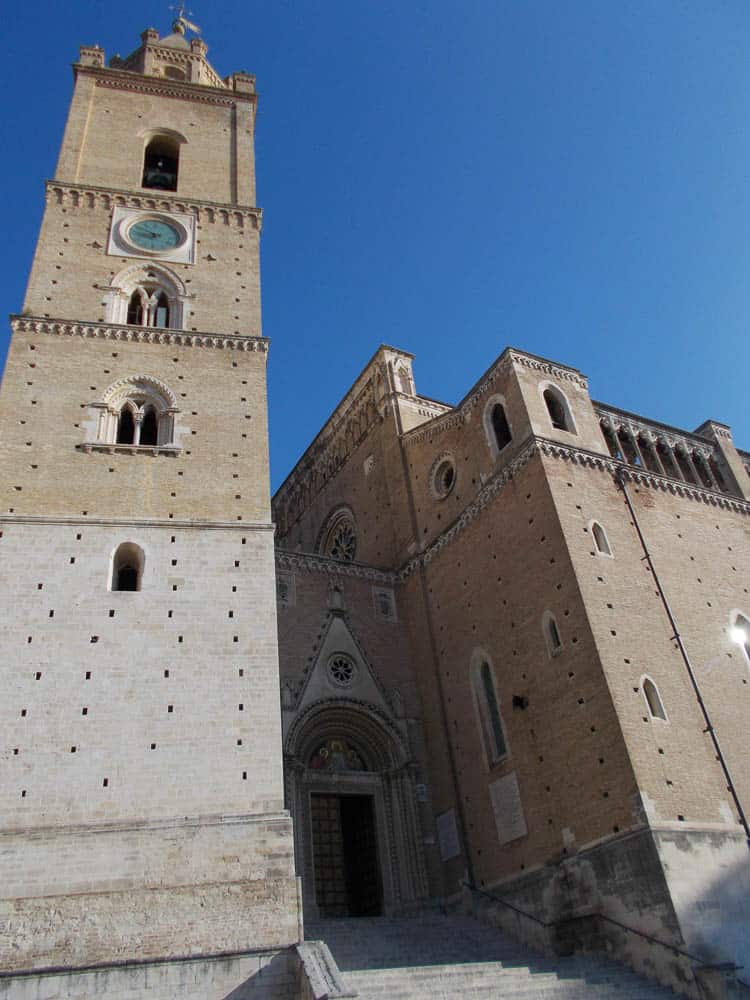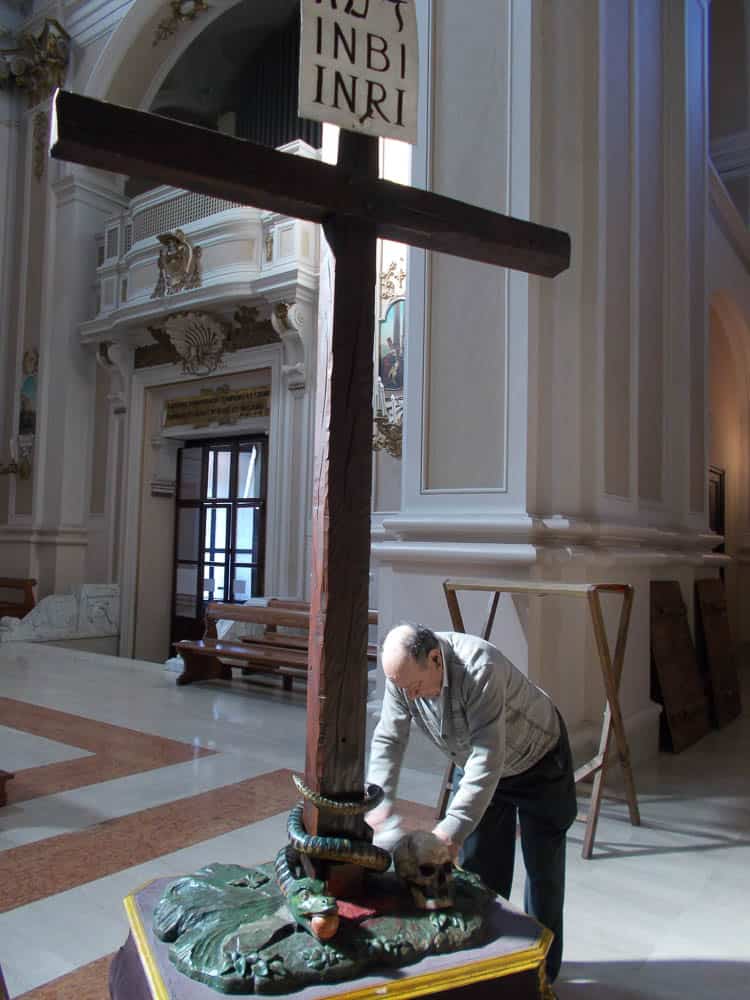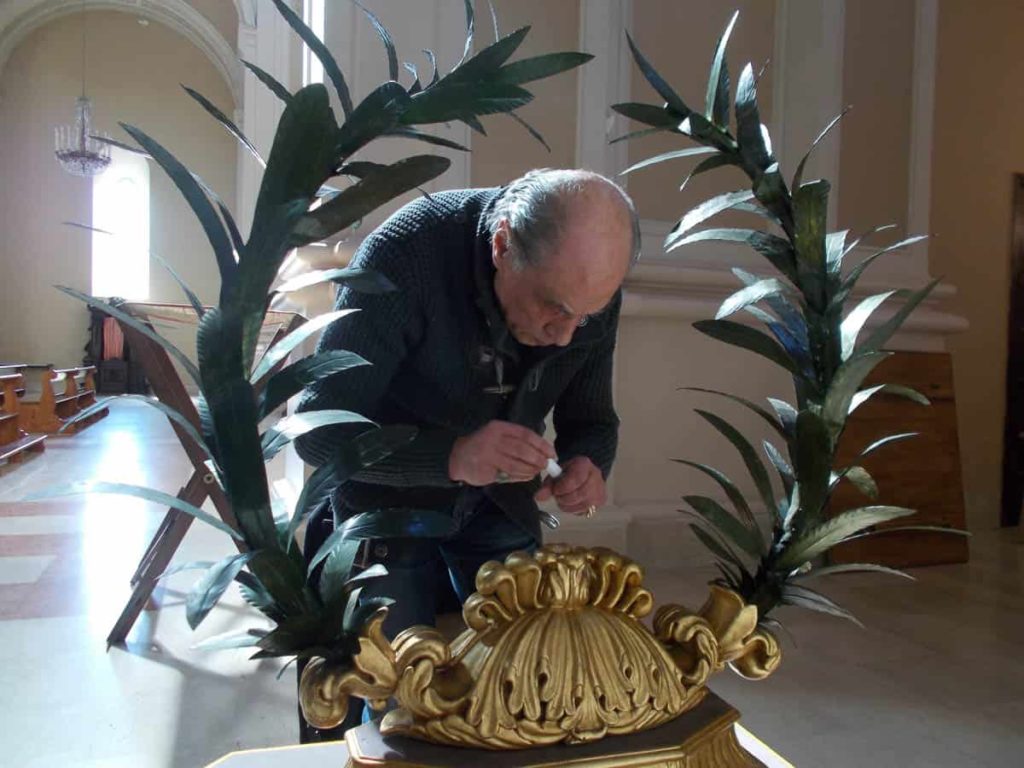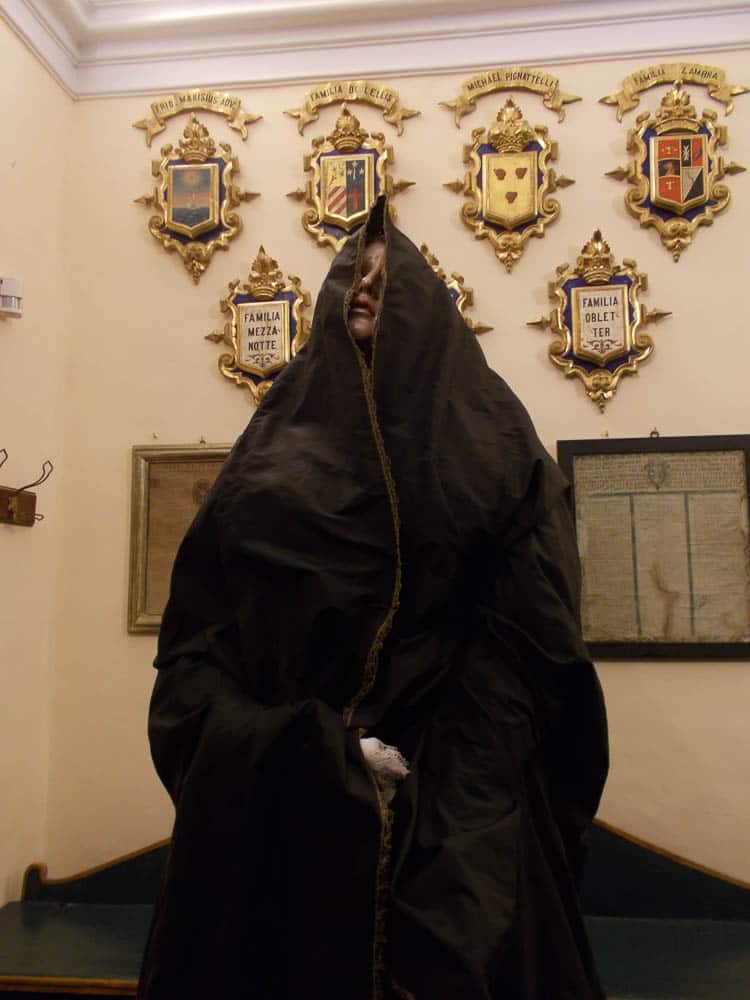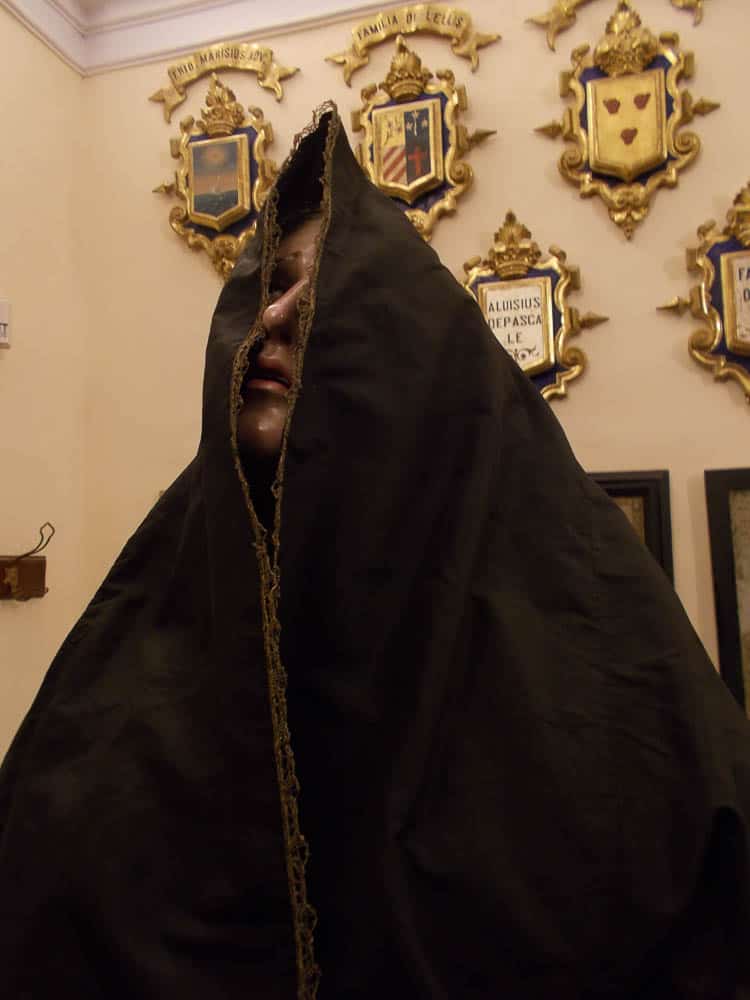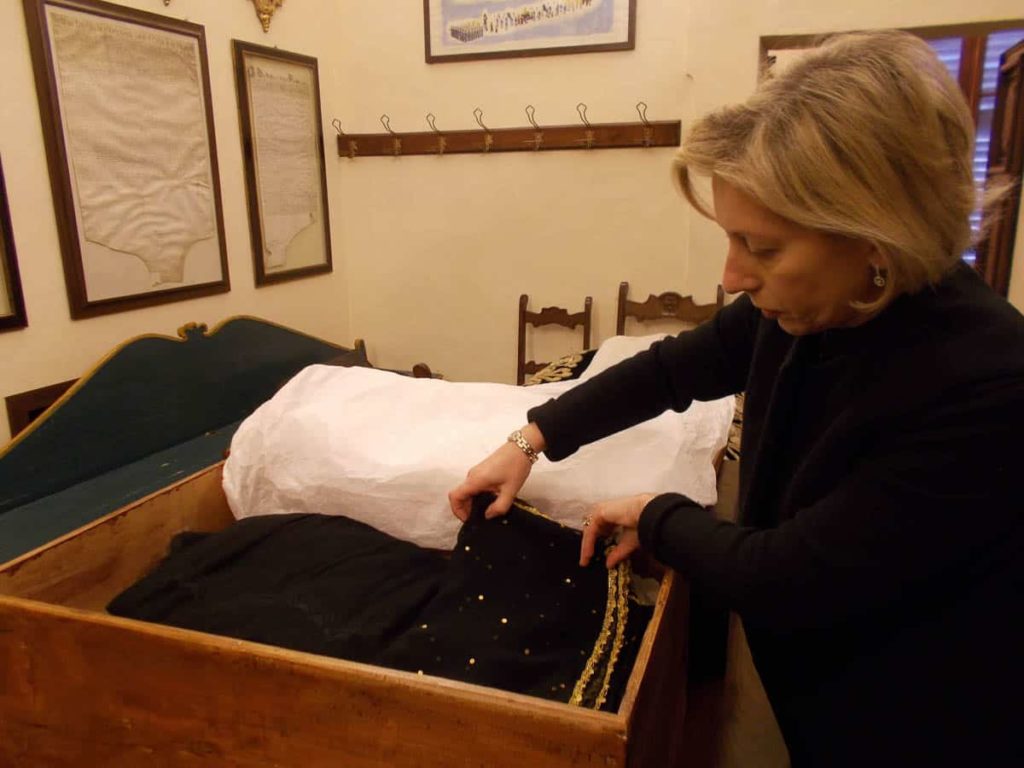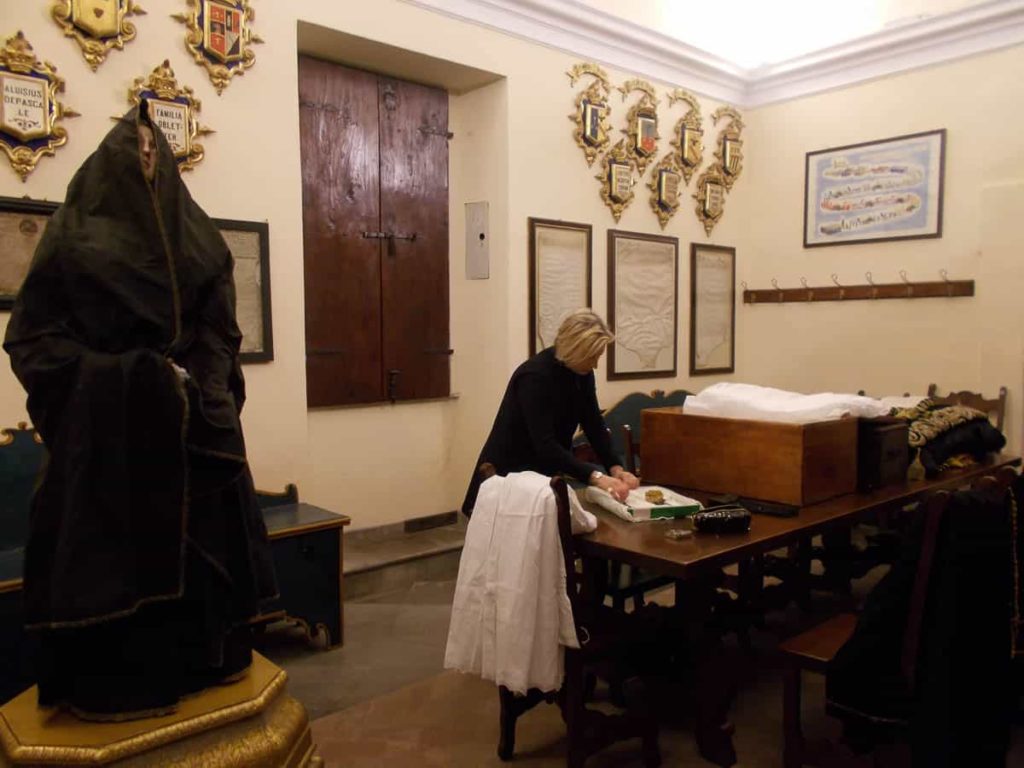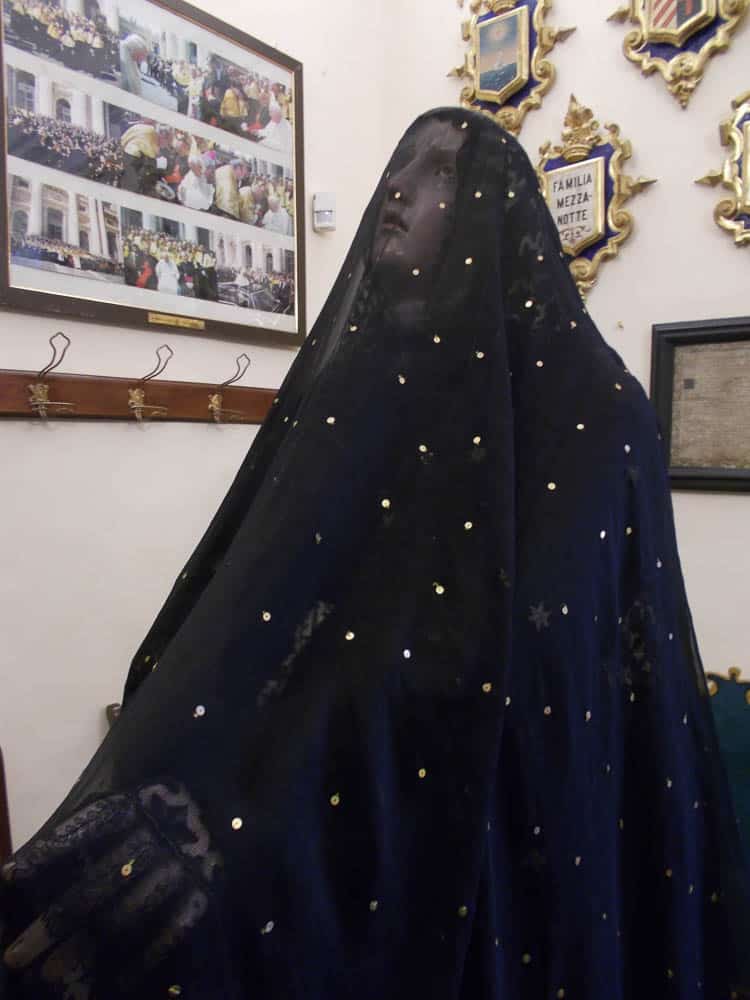- The cathedral of San Giustino, Chieti, Italy, Anna Battista
- Volunteers restore and prepare the procession scenes (1855 by Raffaele Del Ponte, painter, illustrator and set designer) for the Good Friday Procession, Cathedral of San Giustino, Chieti, Italy, photo: Anna Battista
- Volunteers restore and prepare the procession scenes (1855 by Raffaele Del Ponte, painter, illustrator and set designer) for the Good Friday Procession, Cathedral of San Giustino, Chieti, Italy, photo: Anna Battista
- The statue of the Virgin Mary is being prepared in the sacresty of the Chapel of the Arciconfraternita del Sacro Monte dei Morti (Archconfraternity of the Sacred Mountain of the Dead), Cathedral of San Giustino, Chieti, Italy., photo: Anna Battista
- The statue of the Virgin Mary is being prepared in the sacresty of the Chapel of the Arciconfraternita del Sacro Monte dei Morti (Archconfraternity of the Sacred Mountain of the Dead), Cathedral of San Giustino, Chieti, Italy., photo: Anna Battista
- Rita Centobeni, Prioress of the Arciconfraternita del Sacro Monte dei Morti, prepares to dress up the Statue of the Virgin Mary in mourning garment, photo: Anna Battista
- Rita Centobeni, Prioress of the Arciconfraternita del Sacro Monte dei Morti, prepares to dress up the Statue of the Virgin Mary in mourning garment, photo: Anna Battista
- Rita Centobeni, Prioress of the Arciconfraternita del Sacro Monte dei Morti, prepares to dress up the Statue of the Virgin Mary in mourning garment, photo: Anna Battista
- Rita Centobeni, Prioress of the Arciconfraternita del Sacro Monte dei Morti, prepares to dress up the Statue of the Virgin Mary in mourning garment, photo: Anna Battista
- Rita Centobeni, Prioress of the Arciconfraternita del Sacro Monte dei Morti, prepares to dress up the Statue of the Virgin Mary in mourning garment, photo: Anna Battista
- The statue of the Virgin Mary dressed in her mourning gown with veil, photo: Anna Battista
- The statue of the Virgin Mary dressed in her mourning gown with veil, photo: Anna Battista
It’s Wednesday morning and there’s a flurry of activity in the St Giustino Cathedral in Chieti, Italy.
Groups of local men are cleaning and repairing the wooden scenes for the Good Friday procession; chants rise in the distance from the mass taking place in the crypt of the cathedral. In the meantime, Rita Centobeni, Prioress of the Archconfraternity of the Sacred Mount of the Dead, is quietly waiting for a small group of women—seamstress Pina Capista Cirillo, Emanuela D’Amelio, Carolina Obletter and Anna Eletta Sassani Valignani—in the sacristy of the private chapel in the basement of the cathedral. She is indeed the coordinator of a very special all-female rite, dressing the statue of the Virgin Mary in mourning robes for the Good Friday procession. And that is no mean feat.
Historically considered one of the oldest if not the oldest processions in Italy, Chieti’s Good Friday display is about faith, music and theatricality: hooded men from the local confraternities accompany the wooden scenes commissioned in 1855 to illustrator, painter and set designer Raffaele Del Ponte that remember the Passion of Jesus. Two hundred musicians and a choir follow them playing and singing live Saverio Selecchy’s “Miserere”.
Men play a central role in the procession, except in one stage that is strictly prohibited to them – dressing up in mourning attire the wooden statue of the Virgin Mary, donated centuries ago by a local noble family to the Archconfraternity of the Sacred Mount of the Dead.
“It is a very private rite, open only to a few women, all of them sisters from the archconfraternity, and the elderly seamstress, Mrs Cirillo, who is 87 and has been following the ceremony from the last 70 years,” Centobeni, who has been playing this coordinating role for the last twelve years with the faith of a devout Catholic, the passion of a curator and the precision of a seamstress, explains.
“There is a very simple reason behind this secrecy: the statue is completely undressed during this rite, we remove the ordinary clothes the Virgin Mary is wearing, so she is standing in front of us in her underwear from the 1800s. The very act of undressing the Virgin Mary is incredibly intimate.”
The statue is preserved in a wooden closet in the chapel of the oratory of the Archconfraternity, it is wrapped in a solid black cloak, and wears underneath it simple robes that Centobeni describes as “daily home garments”.
Once they are removed, the women start building layer by layer the mourning ensemble, an architectural stage that would have made Cristóbal Balenciaga proud and that Centobeni describes as “moving and incredibly heart-rendering”. The first phase consists of creating a base layer with two cloths, one white and one in a pale yellow shade, that are secured with pins to a bib vest.
“This is the first and most important layer as all the other parts of the dress are anchored to them,” Centobeni explains. “Then we put on the statue two petticoats, one decorated with lace, one with flounces to give structure and support to the outer gowns. A third stage follows with a gown in black faille taffeta, a type of fabric that was very popular among noble women in the 1800s. We secure the gown to the waist with a white ribbon and then add a light sleeveless lace gown, cinched at the waist with a golden cord with two tassels that fall on the left side of the statue.”
Accessories are equally important: the statue wears black fingerless gauntlets decorated with a row of buttons and enriched with white lace wrist cuffs and holds a delicate white handkerchief in her right hand. The mourning gown is completed by two veils, a heavier one with golden stars and a second veil, punctuated by tiny gold sequins. “It looks evanescent,” Centobeni states. “It is secured to the head of the statue in a special way, so that, if there is a light breeze during the procession, you can see the veil moving, a detail that adds a touch of realism to the image of a mother suffering for her son.”
Details are extremely important, even the ones that people may not be able to see while the procession meanders through the streets of Chieti: for example, the two black dresses the Virgin Mary wears have two holes where her heart should be, “We insert in them a sword, hinting at the immense pain suffered by the Virgin Mary when she lost her son. There is no bigger pain as that of a mother losing her child, so this is a very symbolic accessory.”
There is a cathartic power in the statue as her eyes are turned towards the heavens, “She is trying to engage in a dialogue with God, almost asking him for an explanation about Jesus’s death,” Centobeni says. “It is extremely touching and all the people who take part in the procession and see her, feel as if they were living once again their personal pains and sorrows.”
The religious component behind the dressing up rite is strong as everything starts and ends with a Hail Mary and a Salve Regina, while on the Saturday after the procession when the statue is disrobed of her mourning garments and put back in the oratory, Mrs Cirillo, prays the Virgin Mary to give her the strength to continue the tradition bestowed upon her by her aunt. The room where the rite takes place becomes therefore part of a transcendental dimension.
None of the women involved in the rite see it as a duty, but as an honour: Centobeni is an independent modern woman, she is an orthodontist, she is married and has two daughters. One of them, Carolina, 18, already takes part in the dressing up ritual and hopes to follow in her mother’s steps. “I feel privileged being involved in this stage of the procession,” Centobeni says. “Living in our incredibly modern times but at the same time preparing a part of a 400-year-old procession is incredible. It is as if you looked into the future, but had an eye firmly on the past, on your roots and history.”
There is something, though, that may change in the procession as time goes by: for obvious reasons (the wooden scenes are very heavy to carry) men play a central role in the event, but, little by little, things may be changing. “Many confraternities opened up to women in the last few years and sisters and brothers are equal nowadays,” Centobeni says. “I would love to live the procession as an insider and I think one day it will happen, but it will mean taking baby steps and working also on more practical aspects such as the official uniforms and garments, as all the men in our Archconfraternity wear during the procession a black tunic, a golden short cape and a black hood, so we would have to work on the official costumes as well.”
In the meantime, there are other issues to take care of, like sending out a social message through this cultural and sacred event: Mrs Valignani, from one of the historical families of Chieti, hopes people and men, in particular, will re-read the procession from the point of view of the Virgin Mary in her mourning robes. In the last few years, Italy has seen a tragic rise in femicides with women killed by their boyfriends, husbands, and partners for jealousy, for daring to ask for a divorce or for standing up against domestic violence. “We live in very complicated times for women,” Valignani says at the end of the rite after I’m readmitted to the room where the dressing up took place to see the Virgin Mary covered in her black veil dotted with golden sequins. “If only they could look at her as she follows Jesus, crying and with her heart pierced, they would probably understand in a better way the role of women in society, our pains and suffering.”
With thanks to the Archconfraternity of the Sacred Mount of the Dead, Chieti, for allowing me to take some images of the initial and final stages of the rite.
Author
 Anna Battista is a writer, freelance journalist and independent scholar. Her articles about art, architecture, culture, fashion, lifestyle, politics and social issues have been featured in American, British, French, Italian, Portuguese, Russian, Spanish, Swedish publications. Among the publications she has contributed and collaborated with there are Dazed Digital, Port Magazine, The Guardian, Vogue Russia, Vogue Italia and Interview Magazine Russia. She has lectured for many institutions including the Museum of Photography in Moscow and the AA Visiting School Paris at the Musée des Arts Décoratifs, Paris. Anna’s architecture, art, fashion and film notes are collected on her site, Irenebrination, inspired by iconic Italian journalist and fashion and art critic Irene Brin and conceived as a reaction against commercial fashion publications.
Anna Battista is a writer, freelance journalist and independent scholar. Her articles about art, architecture, culture, fashion, lifestyle, politics and social issues have been featured in American, British, French, Italian, Portuguese, Russian, Spanish, Swedish publications. Among the publications she has contributed and collaborated with there are Dazed Digital, Port Magazine, The Guardian, Vogue Russia, Vogue Italia and Interview Magazine Russia. She has lectured for many institutions including the Museum of Photography in Moscow and the AA Visiting School Paris at the Musée des Arts Décoratifs, Paris. Anna’s architecture, art, fashion and film notes are collected on her site, Irenebrination, inspired by iconic Italian journalist and fashion and art critic Irene Brin and conceived as a reaction against commercial fashion publications.

